Evaluating Learning: Assessment Methods & Meeting Learner Needs
VerifiedAdded on 2023/06/17
|7
|1597
|374
Essay
AI Summary
This essay explores the purpose and types of assessment used in education and training, including initial, formative, and summative assessments. It analyzes the effectiveness of these methods in relation to meeting the individual needs of learners, highlighting the benefits and drawbacks of each approach. The essay emphasizes the importance of self-evaluation and peer evaluation in promoting student learning and development. It also discusses the potential for assessment-related anxiety and suggests strategies for mitigating its impact. Furthermore, the role of informal assessments, such as tests and quizzes, in evaluating instructional practices and learner comprehension is examined. The document concludes by referencing relevant books and journal articles.
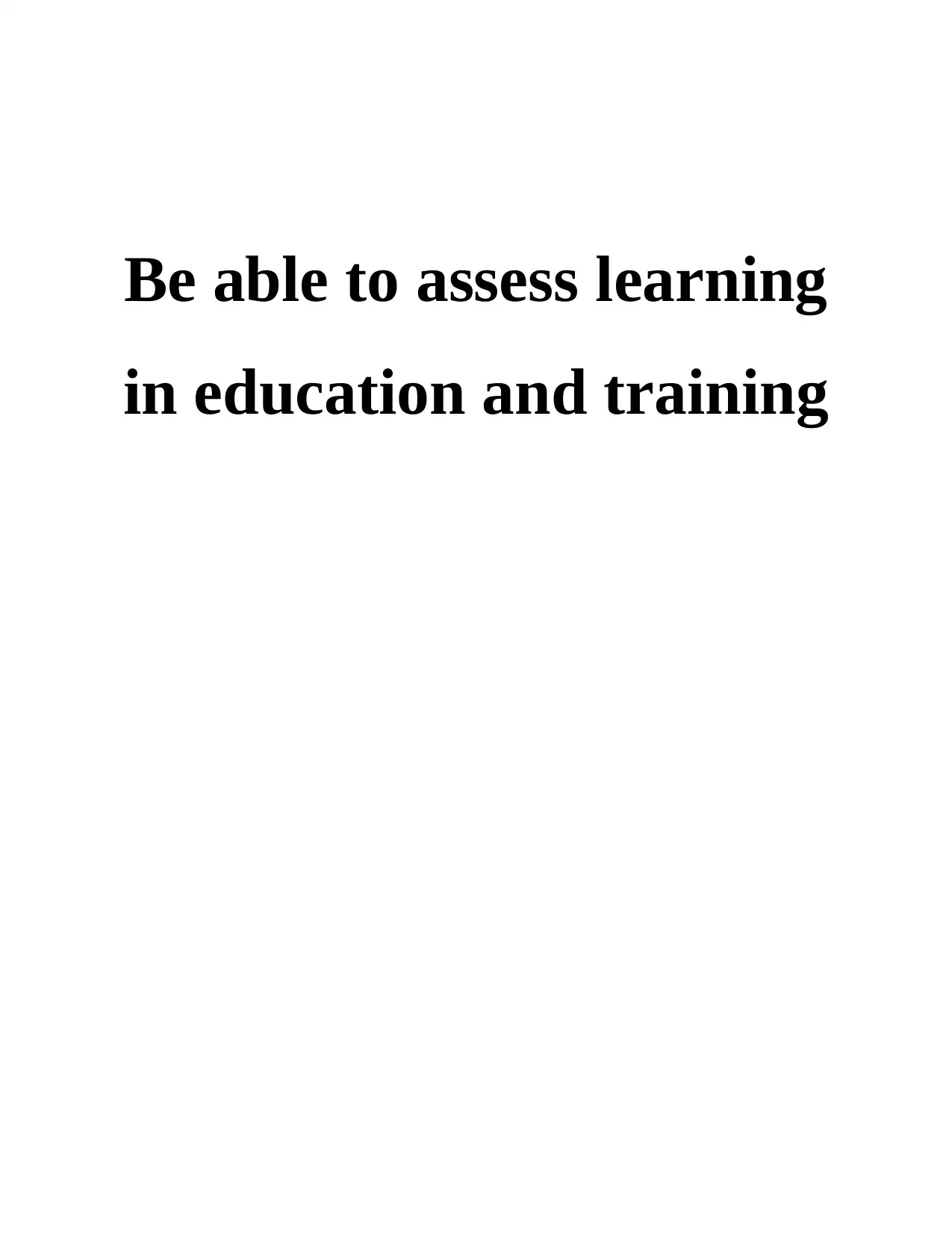
Be able to assess learning
in education and training
in education and training
Paraphrase This Document
Need a fresh take? Get an instant paraphrase of this document with our AI Paraphraser

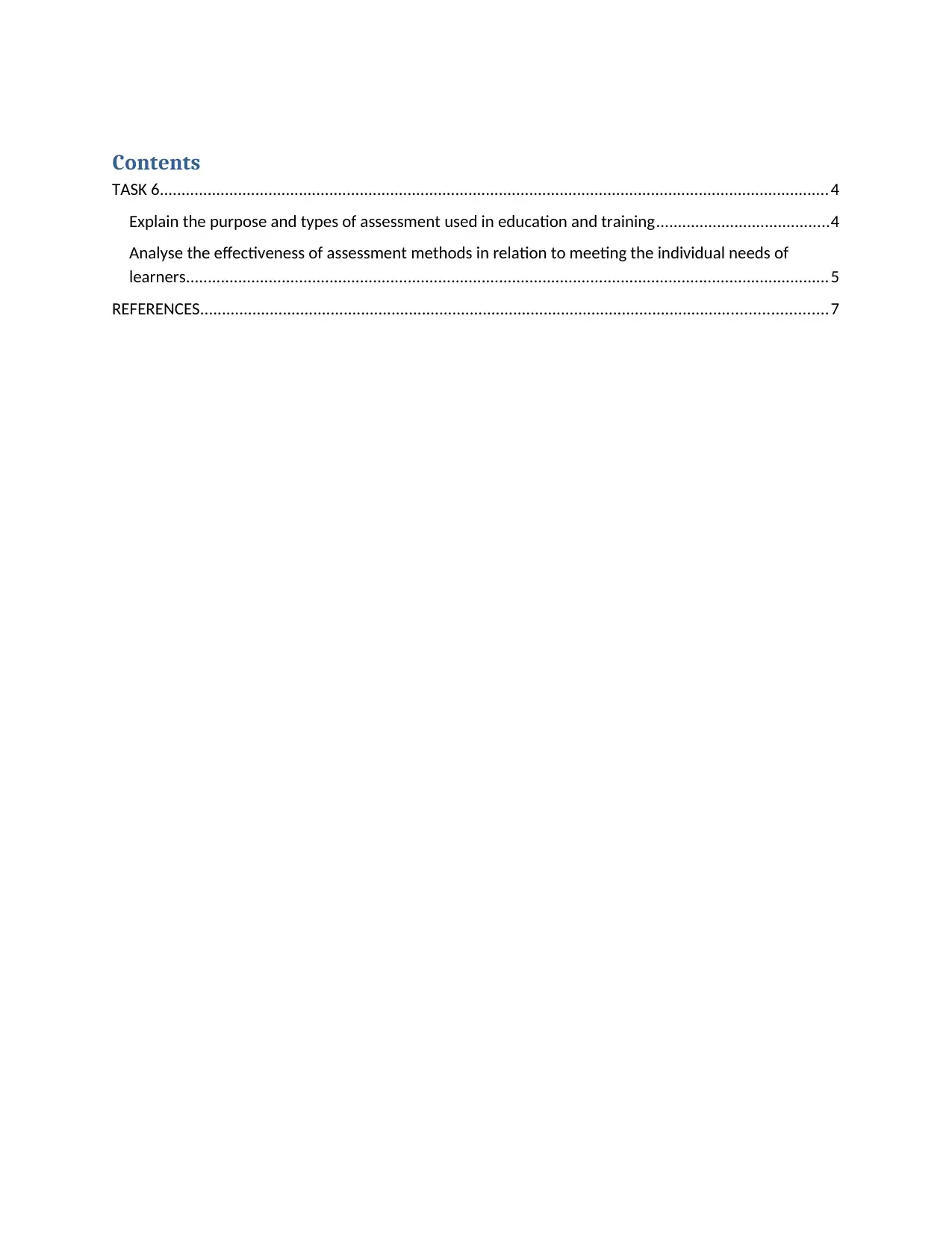
Contents
TASK 6..........................................................................................................................................................4
Explain the purpose and types of assessment used in education and training........................................4
Analyse the effectiveness of assessment methods in relation to meeting the individual needs of
learners....................................................................................................................................................5
REFERENCES................................................................................................................................................7
TASK 6..........................................................................................................................................................4
Explain the purpose and types of assessment used in education and training........................................4
Analyse the effectiveness of assessment methods in relation to meeting the individual needs of
learners....................................................................................................................................................5
REFERENCES................................................................................................................................................7
⊘ This is a preview!⊘
Do you want full access?
Subscribe today to unlock all pages.

Trusted by 1+ million students worldwide
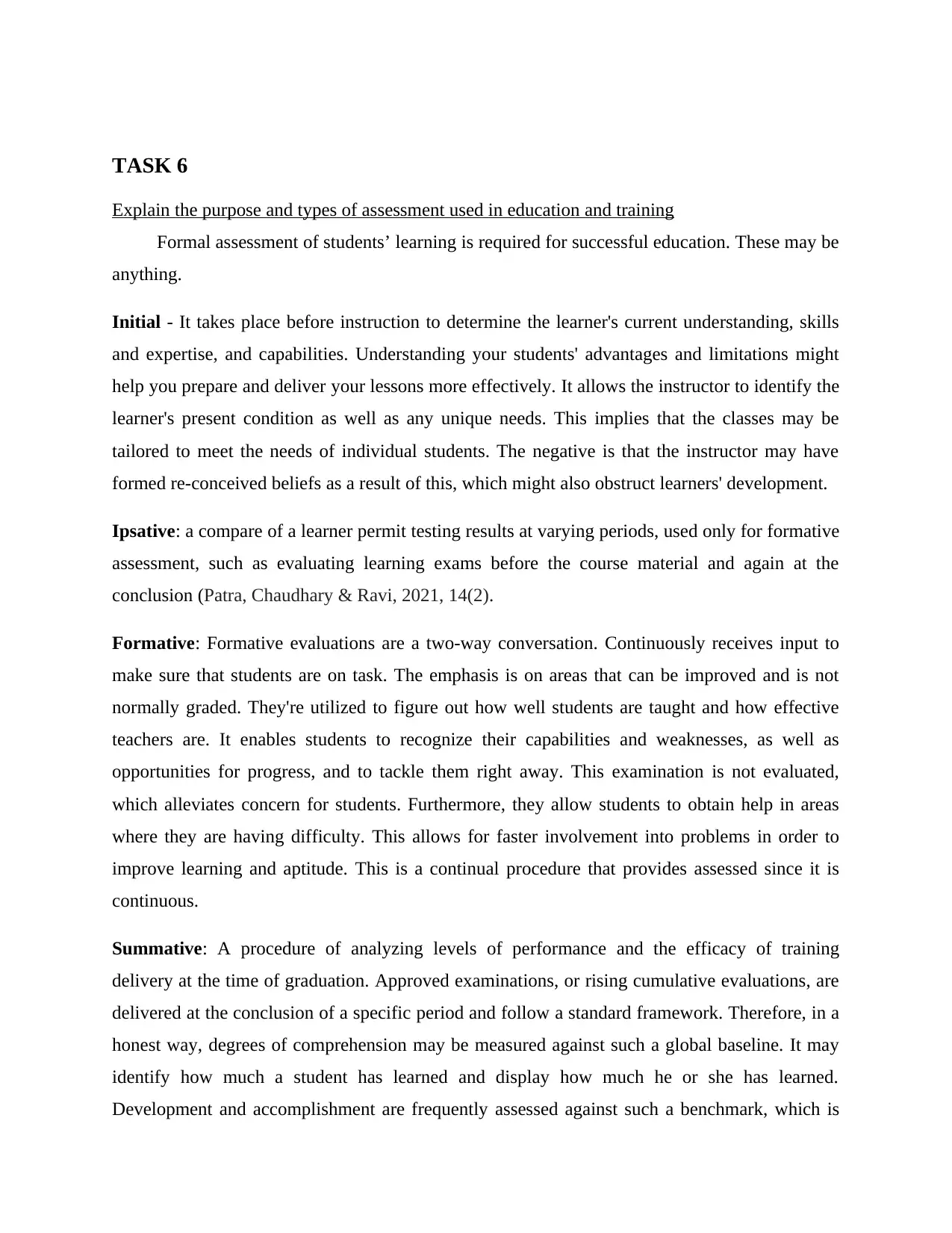
TASK 6
Explain the purpose and types of assessment used in education and training
Formal assessment of students’ learning is required for successful education. These may be
anything.
Initial - It takes place before instruction to determine the learner's current understanding, skills
and expertise, and capabilities. Understanding your students' advantages and limitations might
help you prepare and deliver your lessons more effectively. It allows the instructor to identify the
learner's present condition as well as any unique needs. This implies that the classes may be
tailored to meet the needs of individual students. The negative is that the instructor may have
formed re-conceived beliefs as a result of this, which might also obstruct learners' development.
Ipsative: a compare of a learner permit testing results at varying periods, used only for formative
assessment, such as evaluating learning exams before the course material and again at the
conclusion (Patra, Chaudhary & Ravi, 2021, 14(2).
Formative: Formative evaluations are a two-way conversation. Continuously receives input to
make sure that students are on task. The emphasis is on areas that can be improved and is not
normally graded. They're utilized to figure out how well students are taught and how effective
teachers are. It enables students to recognize their capabilities and weaknesses, as well as
opportunities for progress, and to tackle them right away. This examination is not evaluated,
which alleviates concern for students. Furthermore, they allow students to obtain help in areas
where they are having difficulty. This allows for faster involvement into problems in order to
improve learning and aptitude. This is a continual procedure that provides assessed since it is
continuous.
Summative: A procedure of analyzing levels of performance and the efficacy of training
delivery at the time of graduation. Approved examinations, or rising cumulative evaluations, are
delivered at the conclusion of a specific period and follow a standard framework. Therefore, in a
honest way, degrees of comprehension may be measured against such a global baseline. It may
identify how much a student has learned and display how much he or she has learned.
Development and accomplishment are frequently assessed against such a benchmark, which is
Explain the purpose and types of assessment used in education and training
Formal assessment of students’ learning is required for successful education. These may be
anything.
Initial - It takes place before instruction to determine the learner's current understanding, skills
and expertise, and capabilities. Understanding your students' advantages and limitations might
help you prepare and deliver your lessons more effectively. It allows the instructor to identify the
learner's present condition as well as any unique needs. This implies that the classes may be
tailored to meet the needs of individual students. The negative is that the instructor may have
formed re-conceived beliefs as a result of this, which might also obstruct learners' development.
Ipsative: a compare of a learner permit testing results at varying periods, used only for formative
assessment, such as evaluating learning exams before the course material and again at the
conclusion (Patra, Chaudhary & Ravi, 2021, 14(2).
Formative: Formative evaluations are a two-way conversation. Continuously receives input to
make sure that students are on task. The emphasis is on areas that can be improved and is not
normally graded. They're utilized to figure out how well students are taught and how effective
teachers are. It enables students to recognize their capabilities and weaknesses, as well as
opportunities for progress, and to tackle them right away. This examination is not evaluated,
which alleviates concern for students. Furthermore, they allow students to obtain help in areas
where they are having difficulty. This allows for faster involvement into problems in order to
improve learning and aptitude. This is a continual procedure that provides assessed since it is
continuous.
Summative: A procedure of analyzing levels of performance and the efficacy of training
delivery at the time of graduation. Approved examinations, or rising cumulative evaluations, are
delivered at the conclusion of a specific period and follow a standard framework. Therefore, in a
honest way, degrees of comprehension may be measured against such a global baseline. It may
identify how much a student has learned and display how much he or she has learned.
Development and accomplishment are frequently assessed against such a benchmark, which is
Paraphrase This Document
Need a fresh take? Get an instant paraphrase of this document with our AI Paraphraser
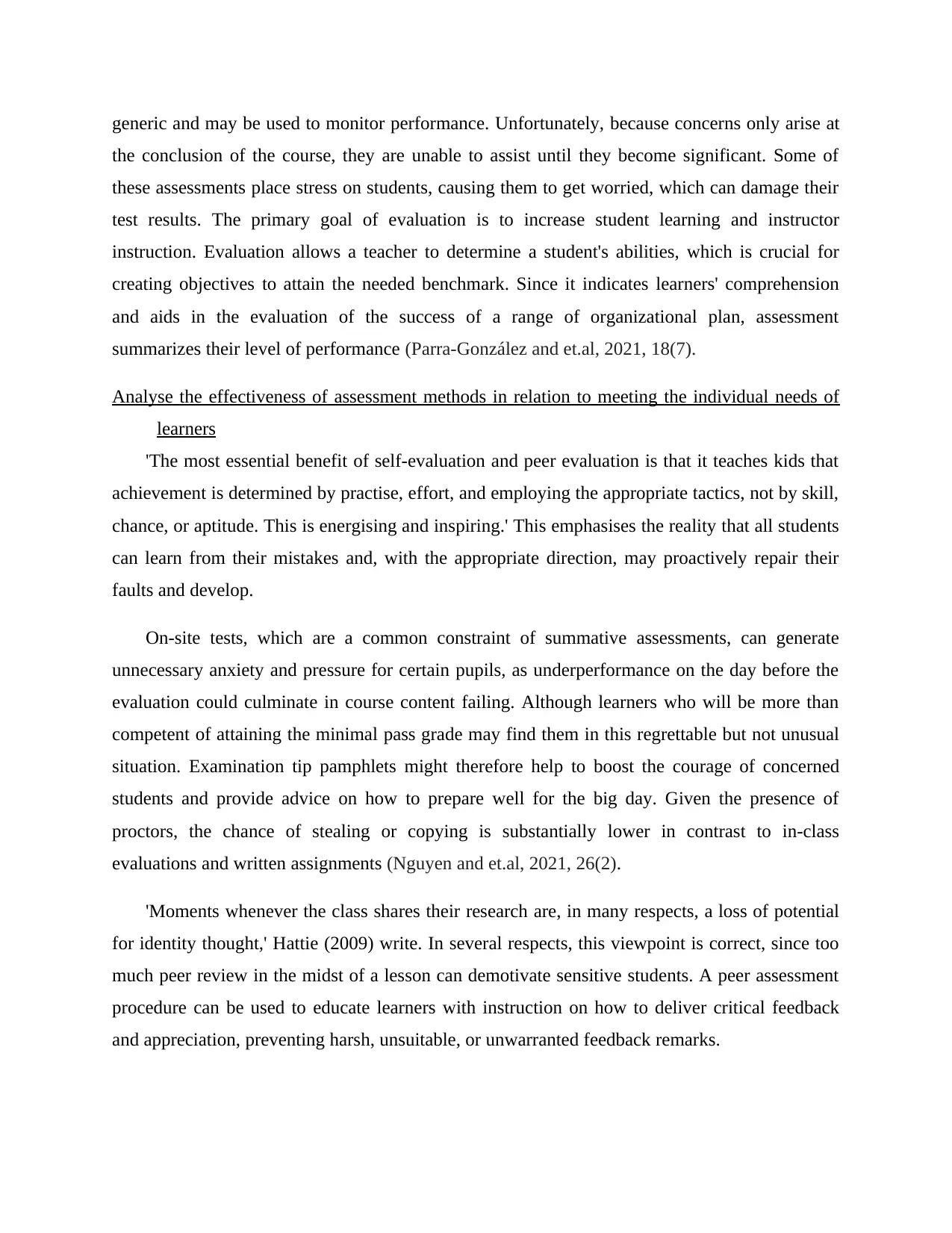
generic and may be used to monitor performance. Unfortunately, because concerns only arise at
the conclusion of the course, they are unable to assist until they become significant. Some of
these assessments place stress on students, causing them to get worried, which can damage their
test results. The primary goal of evaluation is to increase student learning and instructor
instruction. Evaluation allows a teacher to determine a student's abilities, which is crucial for
creating objectives to attain the needed benchmark. Since it indicates learners' comprehension
and aids in the evaluation of the success of a range of organizational plan, assessment
summarizes their level of performance (Parra-González and et.al, 2021, 18(7).
Analyse the effectiveness of assessment methods in relation to meeting the individual needs of
learners
'The most essential benefit of self-evaluation and peer evaluation is that it teaches kids that
achievement is determined by practise, effort, and employing the appropriate tactics, not by skill,
chance, or aptitude. This is energising and inspiring.' This emphasises the reality that all students
can learn from their mistakes and, with the appropriate direction, may proactively repair their
faults and develop.
On-site tests, which are a common constraint of summative assessments, can generate
unnecessary anxiety and pressure for certain pupils, as underperformance on the day before the
evaluation could culminate in course content failing. Although learners who will be more than
competent of attaining the minimal pass grade may find them in this regrettable but not unusual
situation. Examination tip pamphlets might therefore help to boost the courage of concerned
students and provide advice on how to prepare well for the big day. Given the presence of
proctors, the chance of stealing or copying is substantially lower in contrast to in-class
evaluations and written assignments (Nguyen and et.al, 2021, 26(2).
'Moments whenever the class shares their research are, in many respects, a loss of potential
for identity thought,' Hattie (2009) write. In several respects, this viewpoint is correct, since too
much peer review in the midst of a lesson can demotivate sensitive students. A peer assessment
procedure can be used to educate learners with instruction on how to deliver critical feedback
and appreciation, preventing harsh, unsuitable, or unwarranted feedback remarks.
the conclusion of the course, they are unable to assist until they become significant. Some of
these assessments place stress on students, causing them to get worried, which can damage their
test results. The primary goal of evaluation is to increase student learning and instructor
instruction. Evaluation allows a teacher to determine a student's abilities, which is crucial for
creating objectives to attain the needed benchmark. Since it indicates learners' comprehension
and aids in the evaluation of the success of a range of organizational plan, assessment
summarizes their level of performance (Parra-González and et.al, 2021, 18(7).
Analyse the effectiveness of assessment methods in relation to meeting the individual needs of
learners
'The most essential benefit of self-evaluation and peer evaluation is that it teaches kids that
achievement is determined by practise, effort, and employing the appropriate tactics, not by skill,
chance, or aptitude. This is energising and inspiring.' This emphasises the reality that all students
can learn from their mistakes and, with the appropriate direction, may proactively repair their
faults and develop.
On-site tests, which are a common constraint of summative assessments, can generate
unnecessary anxiety and pressure for certain pupils, as underperformance on the day before the
evaluation could culminate in course content failing. Although learners who will be more than
competent of attaining the minimal pass grade may find them in this regrettable but not unusual
situation. Examination tip pamphlets might therefore help to boost the courage of concerned
students and provide advice on how to prepare well for the big day. Given the presence of
proctors, the chance of stealing or copying is substantially lower in contrast to in-class
evaluations and written assignments (Nguyen and et.al, 2021, 26(2).
'Moments whenever the class shares their research are, in many respects, a loss of potential
for identity thought,' Hattie (2009) write. In several respects, this viewpoint is correct, since too
much peer review in the midst of a lesson can demotivate sensitive students. A peer assessment
procedure can be used to educate learners with instruction on how to deliver critical feedback
and appreciation, preventing harsh, unsuitable, or unwarranted feedback remarks.
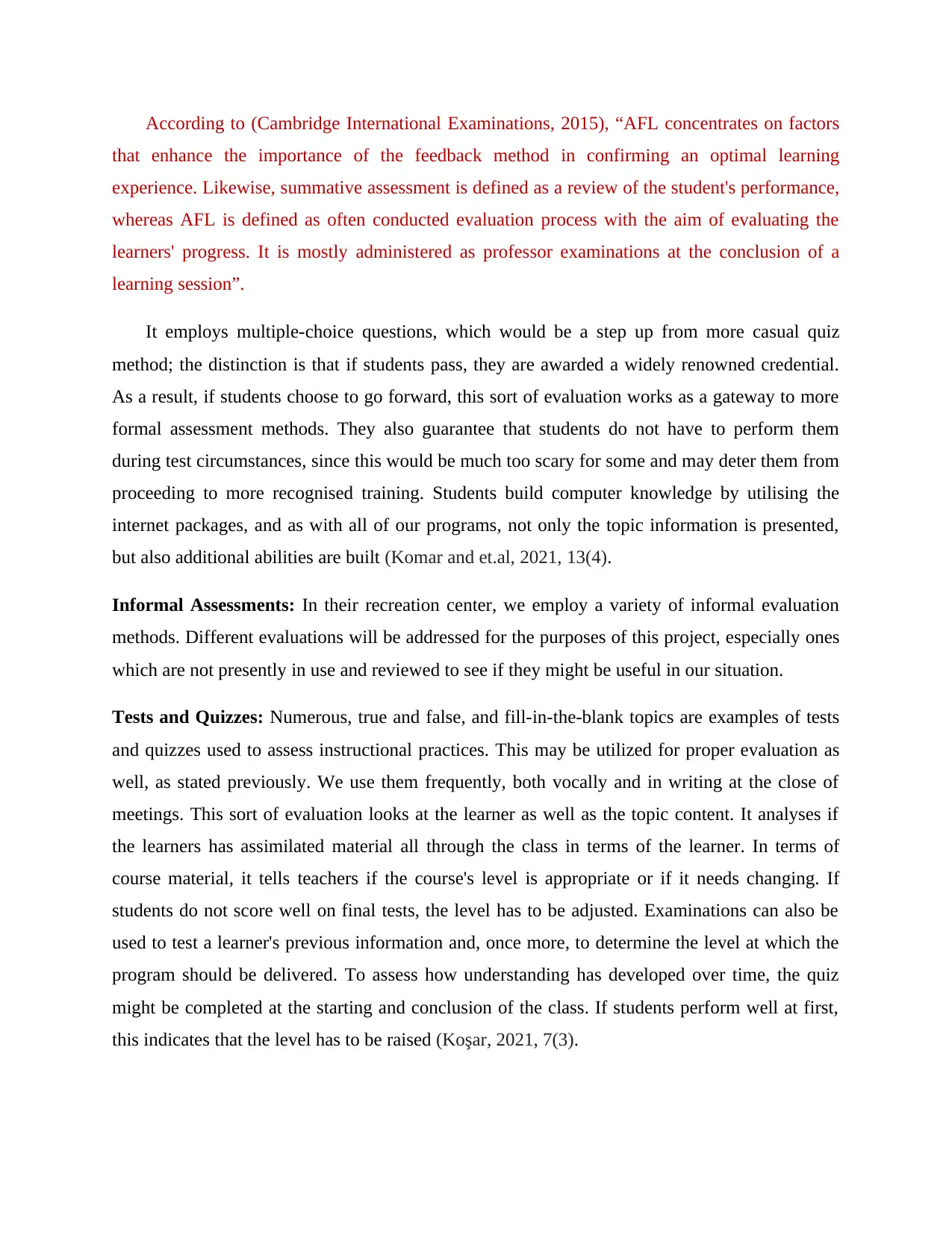
According to (Cambridge International Examinations, 2015), “AFL concentrates on factors
that enhance the importance of the feedback method in confirming an optimal learning
experience. Likewise, summative assessment is defined as a review of the student's performance,
whereas AFL is defined as often conducted evaluation process with the aim of evaluating the
learners' progress. It is mostly administered as professor examinations at the conclusion of a
learning session”.
It employs multiple-choice questions, which would be a step up from more casual quiz
method; the distinction is that if students pass, they are awarded a widely renowned credential.
As a result, if students choose to go forward, this sort of evaluation works as a gateway to more
formal assessment methods. They also guarantee that students do not have to perform them
during test circumstances, since this would be much too scary for some and may deter them from
proceeding to more recognised training. Students build computer knowledge by utilising the
internet packages, and as with all of our programs, not only the topic information is presented,
but also additional abilities are built (Komar and et.al, 2021, 13(4).
Informal Assessments: In their recreation center, we employ a variety of informal evaluation
methods. Different evaluations will be addressed for the purposes of this project, especially ones
which are not presently in use and reviewed to see if they might be useful in our situation.
Tests and Quizzes: Numerous, true and false, and fill-in-the-blank topics are examples of tests
and quizzes used to assess instructional practices. This may be utilized for proper evaluation as
well, as stated previously. We use them frequently, both vocally and in writing at the close of
meetings. This sort of evaluation looks at the learner as well as the topic content. It analyses if
the learners has assimilated material all through the class in terms of the learner. In terms of
course material, it tells teachers if the course's level is appropriate or if it needs changing. If
students do not score well on final tests, the level has to be adjusted. Examinations can also be
used to test a learner's previous information and, once more, to determine the level at which the
program should be delivered. To assess how understanding has developed over time, the quiz
might be completed at the starting and conclusion of the class. If students perform well at first,
this indicates that the level has to be raised (Koşar, 2021, 7(3).
that enhance the importance of the feedback method in confirming an optimal learning
experience. Likewise, summative assessment is defined as a review of the student's performance,
whereas AFL is defined as often conducted evaluation process with the aim of evaluating the
learners' progress. It is mostly administered as professor examinations at the conclusion of a
learning session”.
It employs multiple-choice questions, which would be a step up from more casual quiz
method; the distinction is that if students pass, they are awarded a widely renowned credential.
As a result, if students choose to go forward, this sort of evaluation works as a gateway to more
formal assessment methods. They also guarantee that students do not have to perform them
during test circumstances, since this would be much too scary for some and may deter them from
proceeding to more recognised training. Students build computer knowledge by utilising the
internet packages, and as with all of our programs, not only the topic information is presented,
but also additional abilities are built (Komar and et.al, 2021, 13(4).
Informal Assessments: In their recreation center, we employ a variety of informal evaluation
methods. Different evaluations will be addressed for the purposes of this project, especially ones
which are not presently in use and reviewed to see if they might be useful in our situation.
Tests and Quizzes: Numerous, true and false, and fill-in-the-blank topics are examples of tests
and quizzes used to assess instructional practices. This may be utilized for proper evaluation as
well, as stated previously. We use them frequently, both vocally and in writing at the close of
meetings. This sort of evaluation looks at the learner as well as the topic content. It analyses if
the learners has assimilated material all through the class in terms of the learner. In terms of
course material, it tells teachers if the course's level is appropriate or if it needs changing. If
students do not score well on final tests, the level has to be adjusted. Examinations can also be
used to test a learner's previous information and, once more, to determine the level at which the
program should be delivered. To assess how understanding has developed over time, the quiz
might be completed at the starting and conclusion of the class. If students perform well at first,
this indicates that the level has to be raised (Koşar, 2021, 7(3).
⊘ This is a preview!⊘
Do you want full access?
Subscribe today to unlock all pages.

Trusted by 1+ million students worldwide
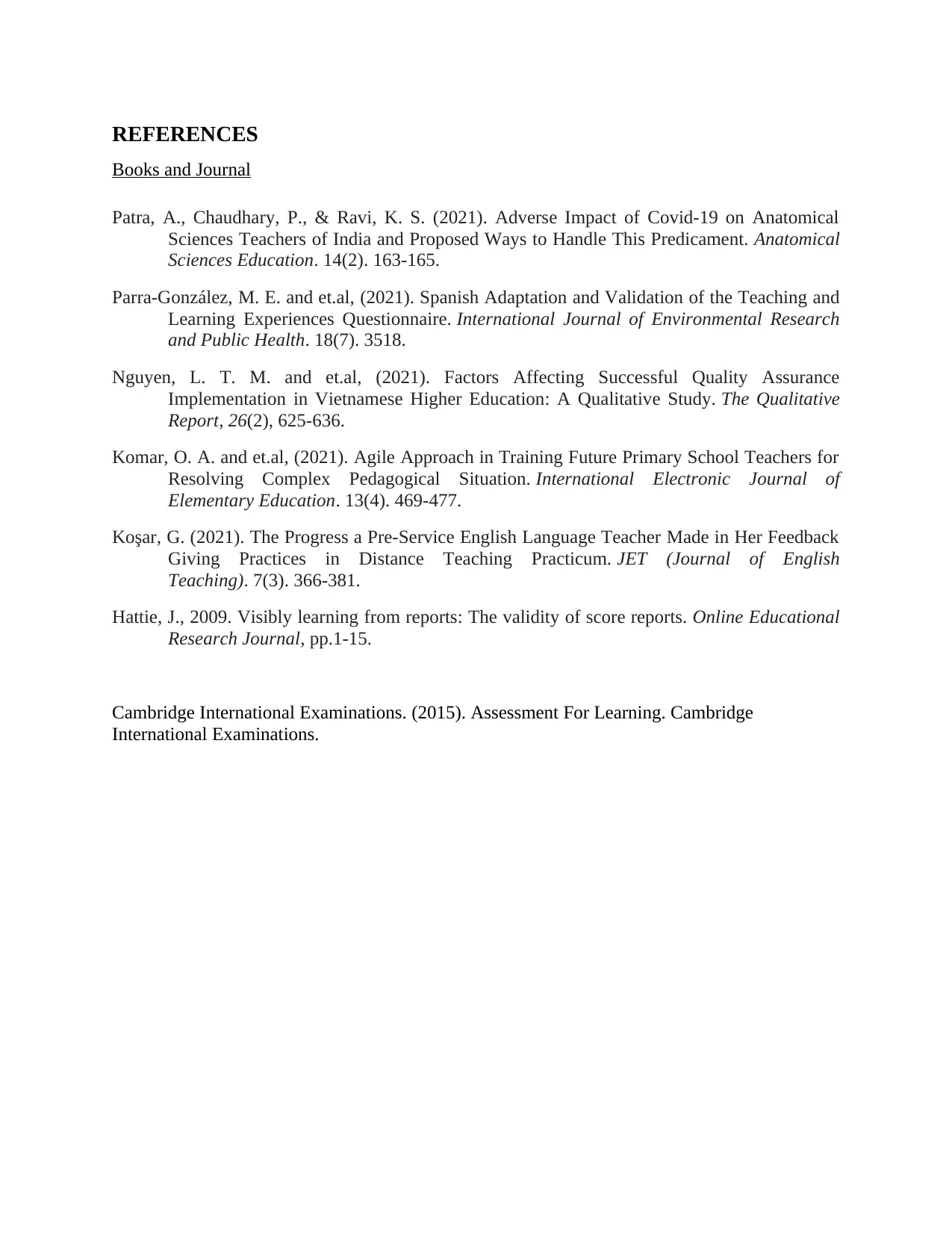
REFERENCES
Books and Journal
Patra, A., Chaudhary, P., & Ravi, K. S. (2021). Adverse Impact of Covid‐19 on Anatomical
Sciences Teachers of India and Proposed Ways to Handle This Predicament. Anatomical
Sciences Education. 14(2). 163-165.
Parra-González, M. E. and et.al, (2021). Spanish Adaptation and Validation of the Teaching and
Learning Experiences Questionnaire. International Journal of Environmental Research
and Public Health. 18(7). 3518.
Nguyen, L. T. M. and et.al, (2021). Factors Affecting Successful Quality Assurance
Implementation in Vietnamese Higher Education: A Qualitative Study. The Qualitative
Report, 26(2), 625-636.
Komar, O. A. and et.al, (2021). Agile Approach in Training Future Primary School Teachers for
Resolving Complex Pedagogical Situation. International Electronic Journal of
Elementary Education. 13(4). 469-477.
Koşar, G. (2021). The Progress a Pre-Service English Language Teacher Made in Her Feedback
Giving Practices in Distance Teaching Practicum. JET (Journal of English
Teaching). 7(3). 366-381.
Hattie, J., 2009. Visibly learning from reports: The validity of score reports. Online Educational
Research Journal, pp.1-15.
Cambridge International Examinations. (2015). Assessment For Learning. Cambridge
International Examinations.
Books and Journal
Patra, A., Chaudhary, P., & Ravi, K. S. (2021). Adverse Impact of Covid‐19 on Anatomical
Sciences Teachers of India and Proposed Ways to Handle This Predicament. Anatomical
Sciences Education. 14(2). 163-165.
Parra-González, M. E. and et.al, (2021). Spanish Adaptation and Validation of the Teaching and
Learning Experiences Questionnaire. International Journal of Environmental Research
and Public Health. 18(7). 3518.
Nguyen, L. T. M. and et.al, (2021). Factors Affecting Successful Quality Assurance
Implementation in Vietnamese Higher Education: A Qualitative Study. The Qualitative
Report, 26(2), 625-636.
Komar, O. A. and et.al, (2021). Agile Approach in Training Future Primary School Teachers for
Resolving Complex Pedagogical Situation. International Electronic Journal of
Elementary Education. 13(4). 469-477.
Koşar, G. (2021). The Progress a Pre-Service English Language Teacher Made in Her Feedback
Giving Practices in Distance Teaching Practicum. JET (Journal of English
Teaching). 7(3). 366-381.
Hattie, J., 2009. Visibly learning from reports: The validity of score reports. Online Educational
Research Journal, pp.1-15.
Cambridge International Examinations. (2015). Assessment For Learning. Cambridge
International Examinations.
1 out of 7
Related Documents
Your All-in-One AI-Powered Toolkit for Academic Success.
+13062052269
info@desklib.com
Available 24*7 on WhatsApp / Email
![[object Object]](/_next/static/media/star-bottom.7253800d.svg)
Unlock your academic potential
Copyright © 2020–2025 A2Z Services. All Rights Reserved. Developed and managed by ZUCOL.





